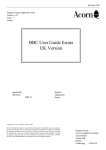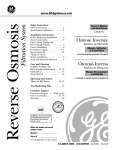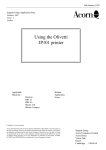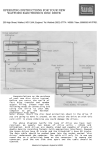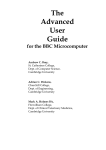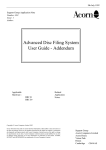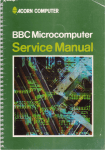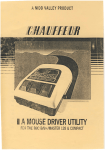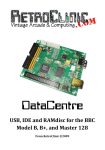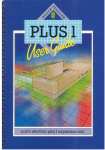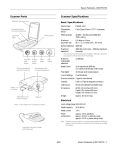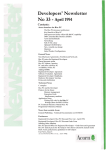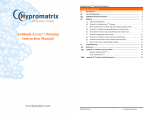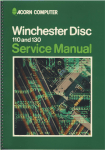Download Disc Filing System User Guide
Transcript
9th July 1992 Support Group Application Note Number: 023 Issue: 1 Author: Disc Filing System User Guide - Addendum This addendum details the differences between the Acorn 1770 Disc Filing System (DFS) and DFS 1.20 as described in the Disc Filing System user Guide issue 2. Applicable Hardware : BBC B BBC B+ Related Application Notes: Copyright © Acorn Computers Limited 1992 Every effort has been made to ensure that the information in this leaflet is true and correct at the time of printing. However, the products described in this leaflet are subject to continuous development and improvements and Acorn Computers Limited reserves the right to change its specifications at any time. Acorn Computers Limited cannot accept liability for any loss or damage arising from the use of any information or particulars in this leaflet. ACORN, ECONET and ARCHIMEDES are trademarks of Acorn Computers Limited. Support Group Acorn Computers Limited Acorn House Vision Park Histon Cambridge CB4 4AE Support Group Application Note No. 023, Issue 1 9th July 1992 General The Acorn 1770 DFS (DFS 2.10) is designed to be compatible with the Acorn DFS version 1.20 (and earlier versions). DFS 2.10 works with a 1770 disc controller whereas DFS 1.20 operates with an 8271 disc controller. Programs/ROMs which directly access an 8271 disc controller will not work with an DFS 2.10 disc system. Most discs that work with DFS 1.20 will work with DFS 2.10, obvious exceptions being protected discs which employ direct access of the 8271 disc controller. DFS 2.10 uses the same commands as DFS 1.20 but some commands have been slightly modified, as detailed below. There is no utilities disc with DFS 2.10 - the *FORM <40/80> and *VERIFY utilities which are disc based with DFS 1.20 are filing system commands with DFS 2.10; references to a utilities disc which occur within the user guide should be ignored. DFS 2.10 contains several new commands which are not present in DFS 1.20 - see below. Throughout this text references to ROM (read only memory) should be understood to include any nonvolatile memory device with ROM compatible connections and access time, such as a 2764, 27128 or 27256 EPROM with 250ns access time. DFS 2.10-only Commands * CLOSE Purpose: closes all sequential files. All disc file data held in RAM output buffers will be copied to the disc. *CLOSE has the same effect as the CLOSE#0 in BASIC. Example: *CLOSE Notes: The minimum abbreviation for *CLOSE is *CL. *EX (<dir>) Purpose: to display information about the specified directory. The information is displayed across the screen (in hexadecimal) in the following order (reading from left to right): <directory name>, <file name>, protection attribute, load address, execution address, length in bytes, start sector number. Examples: *EX $ might give *EX D might give $.!BOOT $.MENU L FF1900 FF8023 00003B 205 L FF1900 FF1900 000332 00B D.ROB FF1900 FFB023 000695 07B D.WORK 000000 000000 000015 2A9 (If no <dir> is given, the currently selected directory is examined). Associated commands: *CAT *INFO Support Group Application Note No. 023, Issue 1 2 Support Group Application Note No. 023, Issue 1 9th July 1992 *FORM <40/80> <(drive)> <(drive)> <(drive)> <(drive)> . . . . . . . etc. Purpose: this command is used to format a disc, enabling it to be used with DFS 2.10 (or with earlier DFS versions). The command has the same function as the utilities described in chapter 7 of the user guide, but has slight operating differences as detailed below. Examples: *FORM 40 Format which drive? 0 GO (Y/N)? Y Formatting drive 0 track <track number> (runs from &00 to &27) (This formats a 40 track disc in drive 0) *FORM 80 Format which drive? 0 GO (Y/N)? Y Formatting drive 0 track <track number> (runs from &00 to &4F) (This formats an 80 track disc in drive 0) *FORM 80 0 2 GO (Y/N)? Y Formatting drive 0 track <track number> Formatting drive 2 track <track number> (Formats both sides of an 80 track disc in drive 0) *FORM 80 0 2 1 3 GO (Y/N)? Y Formatting drive 0 track <track number> Formatting drive 2 track <track number> Formatting drive 1 track <track number> Formatting drive 3 track <track number> (Formats both sides to 80 track discs in drives 0 and 1 of a dual disc drive) Associated commands: *ENABLE *VERIFY Notes: It is not possible to format discs for a 40 track drive in an 80 track drive, nor is it possible to format discs for an 80 track drive in a 40 track drive. (40 track drives use 48 tracks per inch; 80 track drives use 96 tracks per inch.) The formatting process uses some I/O processor RAM space, (approximately 3.5K bytes above OSHWM (usually PAGE in BASIC), so if you wish to save a program you should do so before formatting a disc. When formatting a disc, screen memory corruption may occur in any non-shadow display mode for values of OSHWM greater than &2200. For example, formatting a disc using a BBC Micro with DFS 2.10 and ADFS installed, and with a second processor connected and switched on, will corrupt screen memory in display MODEs 0,1 or 2. It is not necessary to insert a space before any of the parameters following *FORM. Pressing anything other than Y in answer to the GO (Y/N)? prompt results in the formatting sequence being abandoned. Using the *ENABLE command immediately before the *FORM command results in the GO (Y/N)? prompt being omitted from the sequence. Support Group Application Note No. 023, Issue 1 3 Support Group Application Note No. 023, Issue 1 9th July 1992 If formatting a track fails at the first attempt, a ? is displayed after the track number concerned. If the track fails to format after six attempts, formatting is abandoned and a disc fault reported. The minimum abbreviation for *FORM is *FO. *FREE (<drive>) Purpose: to display, for the specified drive, the number of files that can be added to the catalogue together with the amount of space used and left to be used in terms of sectors (in hexadecimal) and bytes (in decimal). Examples: *FREE 31 Files 31E Sectors 204,288 Bytes Free 00 Files 002 Sectors 512 Bytes Used (displays free space in the current drive) *FREE 1 00 Files 038 Sectors 14,336 Bytes Free 31 Files 2E8 Sectors 190,464 Bytes Used (displays free space in drive 1) Associated commands: *COMPACT *MAP Notes: the minimum abbreviation for *FREE is *FR. *MAP (<drive>) Purpose: to display a map of the free space available on the disc. The format is a list of pairs of numbers of the form: <Sector address> : <length in sectors> Examples: *MAP Address : 010 : 10A : 180 : (displays the free space map on the current drive) *MAP 1 Address : 045 : 119 : 200 : Length 004 023 050 Length 001 080 03A (displays the free space map on drive 1) Associated commands: *COMPACT *FREE *EX Notes: If there are a large number of entries in the free space map then the disc contents have become fragmented and compaction is needed. use the *COMPACT command. The minimum abbreviation for *MAP is *MA. Support Group Application Note No. 023, Issue 1 4 Support Group Application Note No. 023, Issue 1 9th July 1992 *ROMS (<rom id>) Purpose: Produces a list of the installed ROMs. The information displayed consists of the ROM socket number (rom id see 'Notes' below), the ROM type, the title of the software in the ROM and its version number, if appropriate. If a <rom id> is included, then information is displayed just for the specified ROM (if it is present). The ROM can be identified by its socket number or by its title. The ROM type is displayed as L for a language ROM, S for a service ROM (eg a filing system ROM), or SL for a service/ language ROM. Examples: (model B+ only) *ROMS Rom 15 : ( L) BASIC Rom 11 : (S ) DFS 2.0 (catalogues the installed ROMs) *ROM 11 (catalogues the ROM with id number 11) Rom 11 : (S ) DFS 2.0 *ROMS BASIC (catalogues the BASIC rom) Rom 15 : ( L) BASIC Notes: The ROM socket numbers for the BBC Micro Model B+ are detailed under the *FX142 command heading in chapter 43 of the BBC Micro System User Guide *VERIFY (<drive>) (<drive>) (<drive>) (<drive>) . . . . . .etc Purpose: checks the integrity of each sector of a disc. *FORM <40/80> performs an automatic verification of each track immediately after formatting it. Examples: *VERIFY Verify which drive? 1 Verifying drive 1 track <track number> (verifies drive 1. <track number> runs from &00 to &27 or &00 to &4F as appropriate.) *VERIFY 0 Verifying drive 0 track <track number> (verifies drive 0) Associated commands: *FORM40 *FORM80 Notes: if the first attempt to verify a track fails, a ? will be displayed with the track number. If the track fails to verify after five more attempts, verification is abandoned and a disc fault is reported. The minimum abbreviation for the *VERIFY command is *V. Support Group Application Note No. 023, Issue 1 5 Support Group Application Note No. 023, Issue 1 9th July 1992 Changed Commands The following keywords to not behave exactly as described in chapter 6 of the user guide: *BACKUP, *DESTROY, *ENABLE *BACKUP and *DESTROY employ a similar prompt system to the *FORM <40/80> command (see above). They do not need to be enabled, but prior use of the *ENABLE command will result in the GO (Y/ N)? prompt being omitted. *DRIVE <drive> The syntax of this command has been changed to: *DRIVE <drive> (40/80). The new parameter allows an 80 track drive to read 40 track discs by double-stepping the drive head. Examples: *DRIVE 1 40 switches drive 1 of an 80 track drive to 40 track disc mode (read only). *DRIVE 1 80 sets drive 1 to 80 track operation. Notes: *DRIVE <drive> 40 and *DRIVE <drive> 80 should not be used with a 40 track disc drive. Attempting to write using an 80 track drive whilst in 40 track mode will result in a 'Disc read only' error message. *FORM ignores the 40 track mode selected with *DRIVE. The *FORM <40/80> command will format the disc size given by the *FORM <40/80> parameter. Note that an 80 track drive cannot correctly format discs for 40 track drives, and vice versa. The command *VERIFY will check a properly formatted 40 track disc in an 80 track drive set to 40 track operation. Error Messages The 'Drive Fault' error message (&C5) has been deleted. Keyboard Links The interpretation of the keyboard link settings varies slightly from the description given in chapter 12, as shown below: Link 3 0 1 0 1 Link 4 0 0 1 1 Step time 6 ms 12 ms 20 ms 30 ms (default) BBC Micro 800k drives give optimum performance with a stepping rate of 6 ms. Drive stepping rates can be set with the *FX255 command. The the BBC Micro User Guide for details. Support Group Application Note No. 023, Issue 1 6 Support Group Application Note No. 023, Issue 1 9th July 1992 Special Starting Procedure for Protected Discs Some discs use specially formatted sectors/tracks which are normally reported as 'faulty' by the DFS. This means that *BACKUP, *COPY, etc. will not read the disc and so the owner of the disc will be unable to reproduce it. Certain formats which were used in conjunction with a 8271 disc controller IC cannot normally be read by a 1770 disc controller. The special loading program which is on a protected disc will not, therefore, work on a machine using 1770 DFS. The model B+ is highly compatible with model B machines; the later OS version 2.00 fitted to model B+ does not normally affect its compatibility. However, some 'protected' programs include an additional test which reads the machine Operating System type code, by using INKEY-256 or its OSBYTE equivalent. Unfortunately, this test fails on the model B+ (OS 2.00). CTRL Z BREAK A special boot loading mode, CTRL Z BREAK, has been introduced into 1770 DFS 2.20 and later. This new mode uses an alternative 8271 emulation technique which may enable otherwise unloadable discs to be booted-in successfully. In addition, the special boot mode returns -1 to the INKEY-256 command and so will improve the compatibility of the model B+ with software written for model B machines. When to use CTRL Z BREAK Normally, discs are booted-in by using SHIFT and BREAK (or SHIFT D BREAK) if DFS is not your default filing system). This procedure will automatically *EXEC a file called !BOOT from drive 0. Always try SHIFT <D> BREAK first. If SHIFT <D> BREAK fails to load a disc, try using the special boot mode SHIFT Z BREAK, or even CTRL SHIFT Z BREAK - (hold down CTRL, SHIFT and Z together, press and release BREAK quickly followed by CTRL, then release SHIFT and Z together). If none of these options will run the disc program, you should check with the software supplier, or the dealer from whom you bought the disc, about its compatibility with 1770 DFS. Support Group Application Note No. 023, Issue 1 7








